#and it's a type of petrified bog wood! :)
Photo

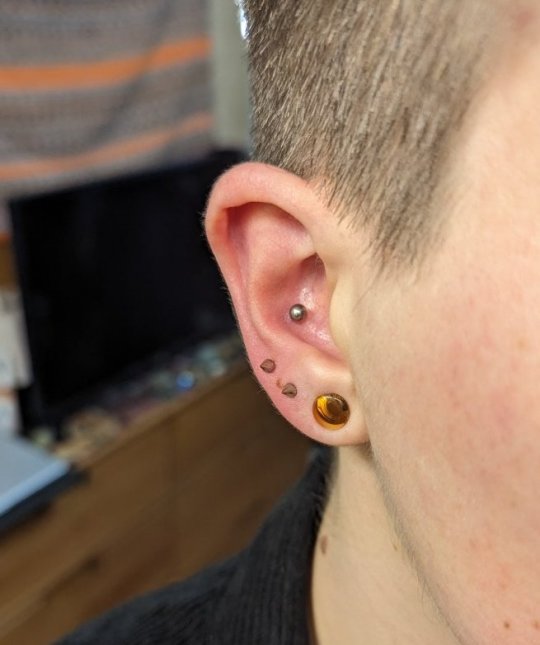
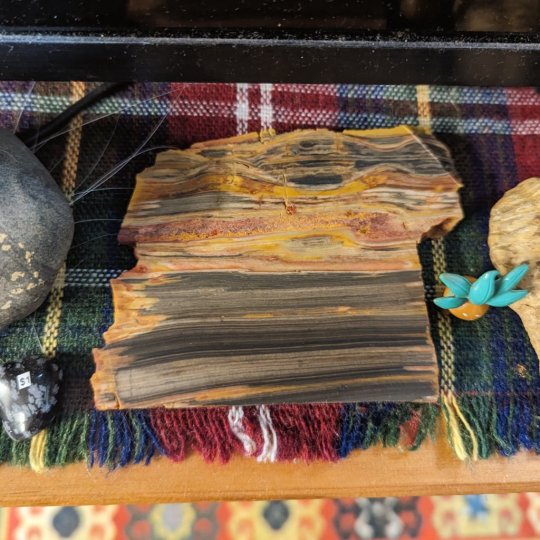
don’t ask me how much this all cost
#the rocks were cheap comparatively#i'm not gonna go cheaper on piercings bc if they're done right this is a permanent thing but it's objectively... frustrating they don't#list all prices online esp bc you are charged per piece aka; the front AND the back#on top of the service itself#but still happy :-)#the left side slab is snakeskin jasper from australia#right side slab is gary green jasper which i don't have an exact location for but it's usually found on the NV/OR border#FUN FACT; gary green jasper is also called larsonite#and it's a type of petrified bog wood! :)#the lapidary also gave me the little agatized gastropod shells on the left of the snakeskin jasper slab!!!#slowly going to re-build my fossil collection my dad trashed#my stuff
5 notes
·
View notes
Photo
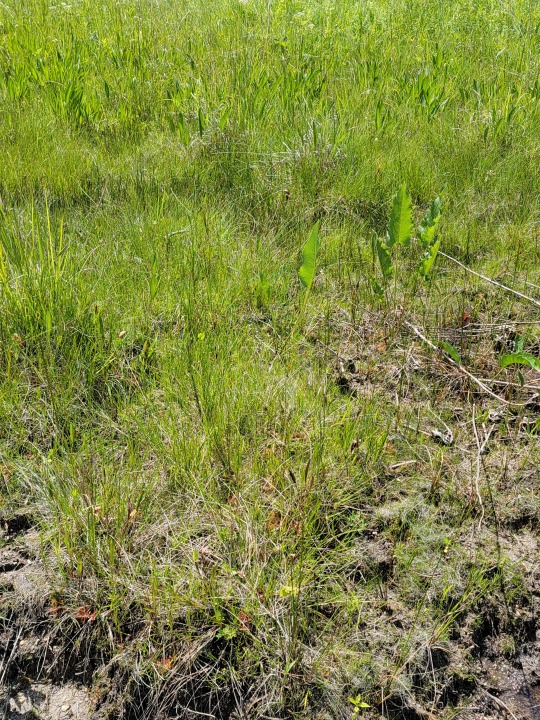
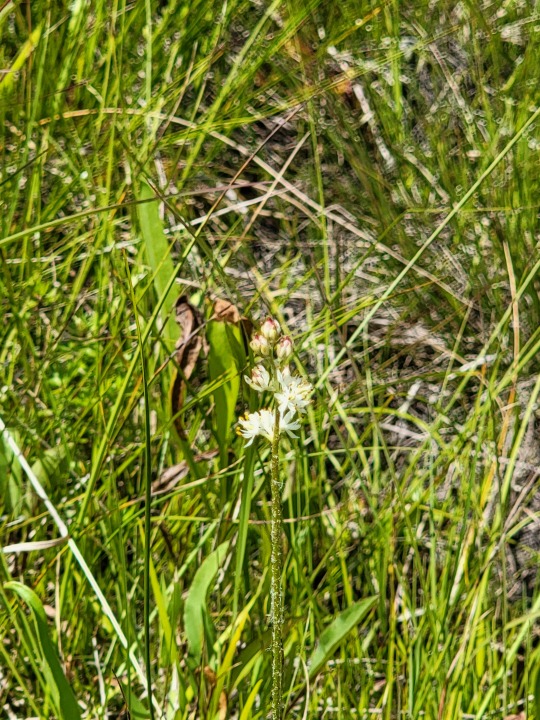




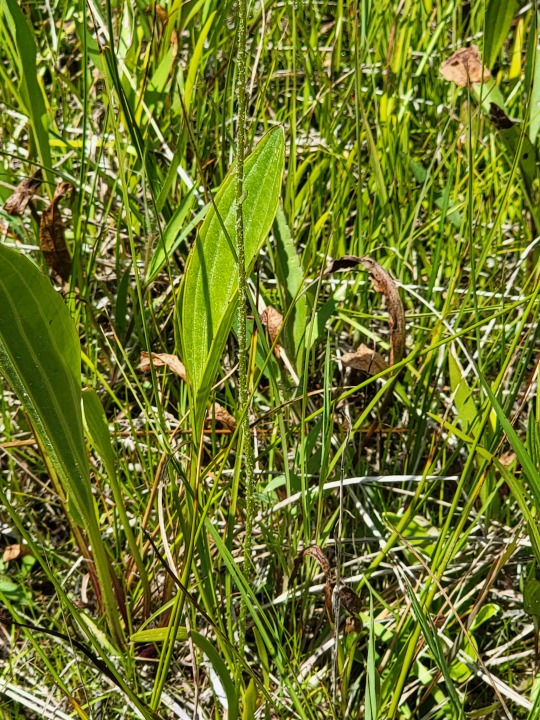
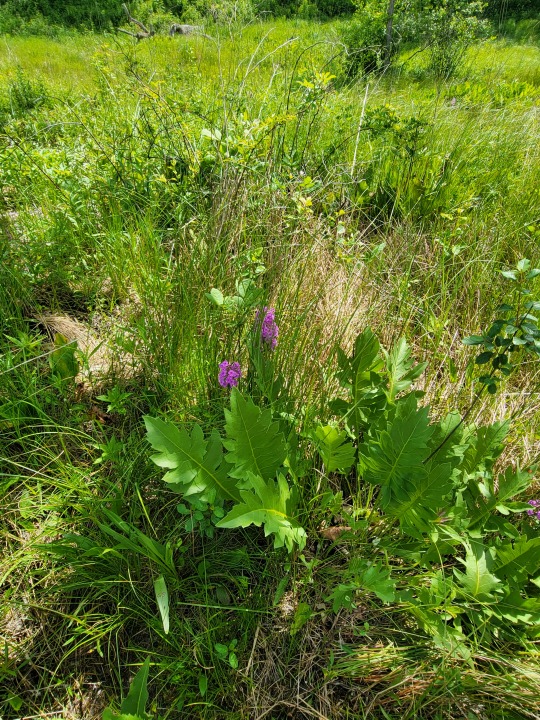


Denizens of the Marl,
My main focus was to introduce an early blooming species that I don’t know if I talked about ever. I usually miss my window to see this plant and for some reason I’ve never gotten close enough to photograph it properly, you can kinda see a gleam of light on the glandular hairs but not well enough to show structure.
Triantha glutinosa, blooms in early June in Ohio but can last till late June and in other states occurs in bogs in warm water conditions and blooms much later which is strange to me. I think this must be an adaptive phenotypical thing but you would expect it to be opposite and light blooming also seems to not be the culprit so I don’t know. False Asphodel is another common name but I honestly prefer calling it sticky or glutinous false ashpodel. As a plant living in these nutrient poor super leached marl flats this plant is a carnivor, protease excretor glandular hair trap specifically, but strangely only on it’s flowering stem and not on it’s minute basal rosette. Opposite of most species that are carnivores most species try to keep traps as far from the flowers as possible which makes sense evolutionary. Glandular traps near an inflorescence seems strange for successful pollination. As it turns out this may be a seldomly pollinated species where most individuals in populations are ancient clones that have formed from rhizome spread overtime in these glacial refugium. The other thing that seems notable is many people studying these false ashpodels (Triantha spp.) run into the same morphology and phenology problems that I have, and have even come to contempt and discourse over specific populations and are evaluating them as part of a biological species complex. I agree on the T. occidentalis western split on all accounts but some of the minor disjunct probable splits seem more complex overall (Central Appalachian mountain populations (TN, VA, SC, GA)
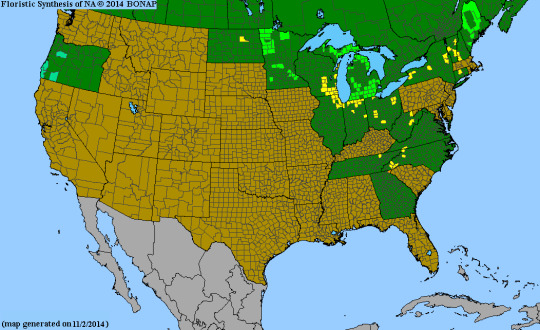
I feel like I can’t stress the importance of this limestone marl and the unique opportunity of getting this close to these plants without any special camera. Though I do wish I had one to display the features properly. Most of the time if you are traversing a fen you have to find and identify petrified marl shelfs or surface travertines, or you are walking on old and ancient tussock clumps from what is usually Carex stricta. Im walking on a displaced gravel shelf with petrified marl and wouldn’t dare to walk off of it and disturb the easily motile banks of loose marl or the suspended marl sediment floating like quick sand. The plants here are fragile and the habitat is equally fragile with many state listed species that cant take damage. Everywhere in the high exposure areas of marl flats are these Drosera rotundifolia and the smooth rounded/heartshaped leaves of grass of parnassas, which is in bloom as I type. Parnassia glauca is so beautiful with it’s unique floral venation and Ill post more pics once again when I get to it. The farther you get from the flats the less exposure and with it comes the sedge meadow with Arnoglossum plantagineum, also known as fen plantain leaved indian plantain. The last few shots are associated with the fully scabrid moderate sized var. ,not species, Silphium terebinthinaceum var. pinnatifidum, which we only see in fens in Ohio and the Ice scoured dwarf willow, Salix myricoides, in all of it’s new leaf glory. Still not looking blue with white pubescent undersides just yet.
Personal note:
Its been really weird doing this lagged posting because these are not matched to the time I was there. Right now, I feel like I should be posting about white bottle gentian, prairie gentian ,fringed gentian or ,andrews bottle gentian and here I am mid June posts. Heck it’s also Spiranthes spp. season and paw paw shaking season rn, most people are smelling sulfur shelves and foraging chicken of the woods(same thing). Trying to catch up and doing documentation and having a place to post personal thoughts on this stuff.
#fens#meadowcore#silphium#salix#salix myricoides#arnoglossum#arnoglossum plantagineum#species complex#carnivourousplant#carnivory#botany#ecology#wildflowers#ohio news#ohio#kawaii#plantblr#botanical#botany on tumblr#plants on tumblr#plants#drosera#drosera rotundifolia#geology#cottagecore#parnassia#parnassia glauca#triantha glutinosa#triantha
24 notes
·
View notes
Text
Valoran World Factbook:
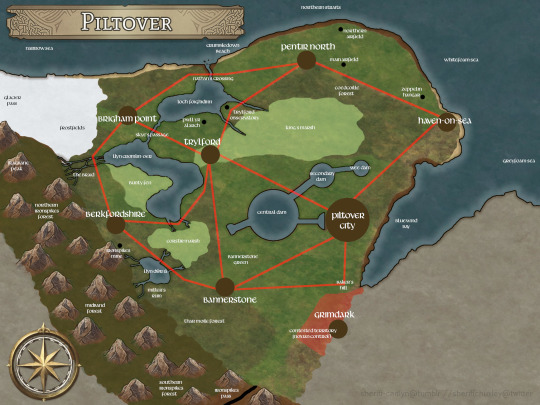
[Larger version of the map here.]
Introduction: Nestled in an ancient meteoric crater in north-western Valoran, the city-state of Piltover is an oddity in the world of Runeterra in a variety of ways. Famously pacifistic, it has not been directly involved in any conflict since the First Rune War, and as such, it has much arable land and many natural resources under its control. This wealth has been the foundation for making the city-state a nearly-unsurpassed figure in the global economy. Piltover is also famous for its focus on advances in medicine, architecture, agriculture, and technology. Its particular focus on hextech and its responsible, positive applications in the world have lead to Piltover being known as the City of Progress. In contrast to its neighbour Zaun, Piltover espouses values of environmental health, personal responsibility, and community-minded politics when it comes to the application of power and technology. Though it has traditionally been allied with Demacia in past centuries, such ties exist merely as a matter of tradition, and Piltover considers itself ‘an ally to all and an enemy to none’, though there is a natural rivalry - bordering on hostility - with Zaun, or with any group or individual that threatens peace, prosperity, or global well-being.
Geography:
Location: North-eastern Valoran
Total area: 814,620 square kilometres
Land boundaries: The Ironspikes Mountain range encircles Piltover to the west and southwest. South and southeast is Zaunite territory, east is the Bluewater Bay and the Whitefoam Sea, which also covers the north. To the west is the Freljordian glacier pass, which is frozen solid for 6-8 months of the year.
Coastline: Northern and Pentir cliffs (white chalk, petrified wood, stone), and Bluewater cliffs (stone, reinforced concrete); pebble-beach at Haven-On-Sea.
Terrain: swampland (28%), marsh/riverine (24%), arable land (20%), mountain (14%), built-up land (6%), bog (3%), fen (2%), glacial (2%), coastal (1%).
Elevation extremes: Lowest natural points: Haven-On-Sea shoreline (sea level); Pwll yr Alarch, Trylford (-15m sea level). Highest natural point: Blagbane Peak, Brigham Point (1328m).
Climate: temperate
Natural Resources: agricultural produce, wild game, fish, timber, peat, solar/wind/hydro/tidal power, swamp gas, salt, concrete, limestone, granite, chalk, flagstone, sandstone, silver
Land use: agricultural, railroad/travel, residential, timber industry, hunting, deliberate/untouched wilderness, recreational, military training
People and society:
Nationality: Piltovian (official). Piltie (derogatory).
Population: roughly 3.5 million; of that, 2 million live in Piltover City
Population makeup: 18% Native Piltovian, 58% mixed heritage (two or more grandparents from different backgrounds), 9% Ionian, 6% Bandle Citizen/yordlekin, 3% shapeshifter or vastaya, 6% other heritage/choosing to remain undefined.
Languages: Northern Piltovian/Ice-Brogue, West Piltovian/Westie/Ein Hiaith, Dusty/Industrial Piltovian, Middletongue, Yordlite, Interzaun, Classique, Language of Gestures, High Ionian, Common Ionian, Trade Ionian, Kalamandian/Trade Pidgin
Worship: Active practitioner (16%), participant (27%), casual/holiday participant (45%), no longer affiliated/unaffiliated (12%).
Focuses/centres of worship include: Church of the Grand Design; traditional Piltovian folk beliefs (either the Deru-Weid or the Owre-ken sídhe worship); Demacian Orthodoxy/Virtus Mos; Leina, Lady of Luck; the Westgate pantheon; the Jie Lai de Wan-Shen-Dien; Ionian folk beliefs (7 traditional variations and 5 modern derivatives officially recorded).
Government:
Country name: Piltover (from the traditional Piltowre)
Government type: Representational Democracy: all statesfolk, mayors, and figures in authority are voted in or out by the population every five years (or every year, for minor figures), and are expected to act as representatives of and according to the will of the city-state’s people.
Capital: Piltover City
Administrative divisions: 8 counties (based on nearest settlement); Piltover city divided into 12 districts, based on quadrants and rings.
Independence: Piltover has always claimed independence from the other city-states. The official date for its establishment as a recognisable nation is often given as 793 BLE, though its physical separation from Zaun is accounted by an event in the First Rune War, in 399 BLE.
National Holidays: Statistically (and not literally), Piltover has a holiday every three days. Most of these are holy-days for various religions or celebrations of traditional beliefs, or the recognition of significant birthdays. Some holidays span more than one day.
Legal System: Civil law
Executive branches: Leading authority: The Statesfolk of Piltover (112 head statesmen; backed by supportive parties). Mayors of Districts (20). Mayoral Council (8 per mayor), Piltover Commissary (Sheriff (1), then Constables, Wardens, Detectives and Post-Guards). Local watches and quorums are held often by various communities.
Legislative and judicial branches: As above. Piltover does not follow the trias politica as most nations do.
Civics and Infrastructure:
Calendar structure: A year with four seasons, each season with four months. Each month is made up of three standard 10-day weeks, with some variables depending on week and season; every four years, there is a leap day celebrated in the first month of Spring. Further details.
Transportation: Piltover is famous for its rail lines, which criss-cross the entire state and connect every major settlement (except Grimdark, due to the Treaty of Black Pools). The majority of the lines are built on limecrete and stone viaducts, to prevent freezing/flooding/damage to the tracks. Within Piltover City, there are also electric trams that service each of the rings of the city. Bicycling and horseriding is common. Less common are hextech automobiles, which are not only expensive to own and maintain but are also subject to many laws and licenses that make such conveyances undesirable to most. There are still horse-drawn carriages, though in Piltover City the majority of the ‘horses’ are automatons.
Water: Piltover’s hydroelectric system - a series of three interconnected dams - also acts as a purifier for drinking water, supplying the entire city and maintaining a reservoir. Every rural centre also has its own water purification centre. Running water can be found in almost every Piltovian built-up area.
Telecommunications: Radio is Piltover’s primary means of communication. The nation has very reliable and speedy postage system, supplemented by the use of mechanical messenger birds for long-distance letters. Hexphones are ubiquitous, connected to a semi-radio-based network for exchange of information and communications. Hexscreens for viewing moving pictures are present but not commonplace, due to their expense; they are usually present in communal areas such as bars, theatres, and community halls. They are not as popular as film projection is.
Waste disposal: Whether in the city or in the rural centres, sewer waste is often processed in purification systems before being either processed in natural gas production plants, made into fuel, or returned (in treated form) to fields as fertiliser or to marshes and fens to be cycled naturally back into the environment. All other garbage and waste products are recycled or repurposed in the same way, with very rare occasions of burning or melting of non-recyclable materials (a rare occurrence given Piltover’s focus on ecological care and recyclable/biodegradable materials).
Education: Primary school (ages 6 through 12), Preparatory school (ages 13 to 16), College (age 16 and upwards). It is expected that all citizens of Piltover be fluently bilingual (at the bare minimum; being fluent in three or more languages is encouraged). National literacy level: 89.5%, the highest for any nation on Runeterra.
Health: Piltover marries much scientific advancements with traditional medicine and white magic. Healers and physicians from Piltover often deliberately make their way to war-zones to treat the injured, regardless of ‘side’. Hygiene is of high value and importance.
Architecture: Much of Piltover City’s construction is stone, glass, iron, brass, bronze, concrete and limecrete. Other urban centres forego the glass and iron, supplementing instead with wood, thatch, mud-brick, and slate. Design in the city tends to lean towards an art-nouveau style, though throughout the city-state there is a focused intent on construction that can endure and insulate against the colder climate; insulation and alignment with the passage of the sun assist in this, as well as building in close clusters or underground (depending on the landscape and population).
Economics:
Currency: Dogma (gold standard), arian (silver), drake (rarely used silver), half-drake (silver alloy), quid (tin or paper), penny (brass). Further details.
Employment of population: Agricultural (31%), Civic/Infrastructure (28%), Railroad/Transportation (13%), Education/Politics (7%), Financial/Mercantile (7%), Medical (6%), the Arts (6%), Religious (2%), Constabulary (.006%)
Military:
Military branches: Piltover Constabulary (local). Yordle Military (external, includes the Yipsnakes Aerial Corps).
Military service age and obligation: There is no mandatory military service for Piltovian citizens. Those who wish to become part of the Constabulary are expected to undergo at least four years of training (physical, mental, and intellectual), with the minimal age of consideration for service being 14. Yordle citizens of Piltover generally follow the Bandle City laws for military service, though exceptions exist, particularly if they choose to serve in the Constabulary instead.
Manpower available for military service: As of 31CLE, the Piltover Constabulary has roughly 18000 members in active service. There is also a semi-permanent outpost of the Yordle Military present in Piltover of around 4000 members, varying between commanders, practiced ground troops, pilots, and privates/trainees.
Military allies: In addition to the Bandle City Military, Piltover has also previously called on military aid from Demacia, Noxus, Avarosa, Lokfar, and the Untethered.
Trans-national issues: There is a general mood of anything between rivalry to animosity against neighbouring city-state Zaun. Border disputes between Piltover and Zaun are uncommon, for the most part, as boundaries are something traditionally respected by the cultures that inhabit the crater and the border itself. After the Battle of Black Pools, parts of the territory around Grimdark was ceded to Zaun, under Noxian control, for the purpose of oil drilling. The oil drilling operations have since come to an end, but neither Zaun nor Noxus have opened talks about returning the territory; Piltover will likely begin pushing more heavily for political discussions in the months to come. Piltover is largely on friendly terms with Noxus, particularly after Noxus’ direct aid and intervention after Jinx’s terrorist attack. Demacia broke its old alliance with Piltover after The Bastion, though talks are now underway as King Jarvan IV wishes to rekindle - at the very least - an alliance for the sake of trade. Piltover continues to take in refugees from any area of conflict - notably Ionia and Noxus, but also infamously from Zaun - and often refuses extradition of any kind. Piltover supported both sides, the Avarosan and Winter’s Claw, of the Freljordian Conflict, but remains on good terms with both despite this.
(Template taken from here, map base made here.)
#worldbuilding#Piltover builder#politics#civics#infrastructure#piltover#tablet art#i have been working on this for literal years#be FREE my creation!!!#not your piltover#map
8 notes
·
View notes
Photo


This is a very unique pair of bookends made from jasper replaced petrified wood, collected from Marston Ranch near Ashwood, Oregon. This petrified wood is often referred to "bog wood" as it's thought to be a bog layer in a swamp that was covered over and petrified. The jasper replacement leaves a beautiful coloration with hues of reds, yellows and blues, but unfortunately destroys the detail that would allow for the type of tree to be identified.
Each bookend slightly varies in size, with one measuring 9.5" tall, 6.7" wide and 1.8" thick, while the other is 9.5" tall, 6.8" wide and 1.75" thick.
Just added for sale at FossilEra.com
207 notes
·
View notes
Text
NORI’DUN HUMAN SUBRACE
the next race i have most mapped out are the northerly human clan: a subrace of very tall, heavy set and muscular humans who reside in the moorlands alongside goblins and orcs. While orcs are mostly nomadic, these barbaric humans sort of bridge the gap between the endless bogs and the more varied mountain range that borders the kingdom’s edge. They often act as a trade mediator between the goblins and orcs, but also will live amongst and intermingle with the two races.
they call themselves the Nori’dun (bastard mix of the little gaelic i know paired with icelandic (or olde english depending which sounds cooler lol) which i know nothing about!), common folk to the south hardly know they exist but those who do refer to them as the North Folk, Norfole, or Nawfelv.
their society is matriarchal, with a head mother leading small clans who exist in settlements that pepper the moors at the mountain’s feet. the great mother choses a small group of esteemed individuals to act as her council, and this group travels from one settlement to another, spreading news and diffusing ideas. They act as merchants as well as bards and scholars, and report back to their home establishment bringing back goods and valuable knowledge. this council tends to be the only literate individuals, but even then their writing system is simplistic and much like the goblin written language, focuses primarily on identifying items and their quantity for trade purposes. many of the symbols used to denote trade don’t have a spoken equivalent, and common nori people have no use or even knowledge of this system. they do make use of pictogrographs, though there is hardly a commonality between tribes and most images rely on rudimentary depictions of humans or animals, and are mostly created for art or entertainment.
nori people live in pueblo-like buildings crafted out of a brick called ‘vergs’, made of peat, peat moss, gravel, and guano. the mixture is shaped into blocks and fired, then stacked into long, rectangular modules and set with a slit like mud/clay type mortar, and then finally covered in a thin limestone paste gathered from within the mountains. Once the paste fills any gaps and sets, the structure is often painted using natural dyes and pigments such as soot and charcoal, animal bloods, fats, or waste, berries, local roots, vegetables, and plants such as lichen or moss, and various soils such as clay, lime, or peat. The outer architecture also utilizes bits of stone or petrified woods to border door frames or window holes in a peg like fashion, and painted designs (differing from tribe to tribe) tend to use simple lines, borders, or geometric figures surrounding entrances and exists. the interiors are similarly overlaid with lime but usually not painted like the outside of the homes. the arrangement centers around an elongated room dedicated to cooking and eating; there is usually a large fire pit surrounded by seating in the center of these rooms-- like so:

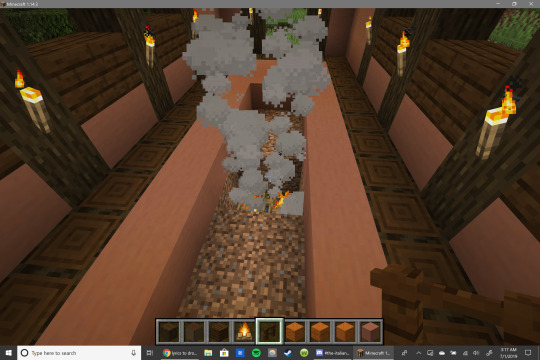
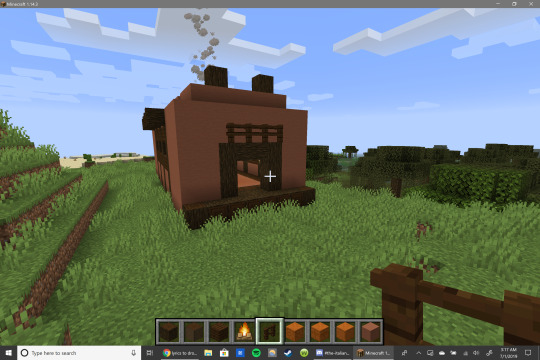
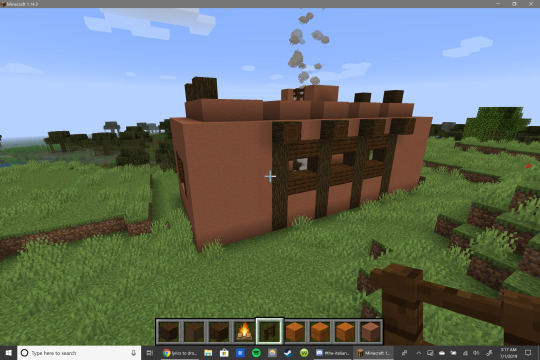

not the best example but still gives you an idea of the CENTRAL room layout. additional modules are merged, called ‘ryms’ for sleeping quarters, storage, or religious purposes. minecraft doesnt lend much to decor but there would be shelves and cabinets, baskets and even counter like constructs with hollowed innards for food and wares storage. the top chimney like openings are outfitted with stones in place of the fence I used, and during heavy storms they are covered dried and stretched animal skins. otherwise the water collects in the central fire pit and drains out of through a small and simplistic network of clay enforced tunnels that run under and down from the house. the pits are not as deep as depicted, and the houses are built on a foundation of dirt and rocks that elevate the fire pit just enough for these tiny pipes to run downards.
nori make use of the limited supply of wood for structural reinforcement and decor in important settlement buildings such as the clan’s meeting hall, temple, great hall, or the great mother’s home. decor ranges from dyed and painted animal hides, woven linen tapestries, wreaths, dried and hollowed gourds, animal bones, weaponry, metal work, baskets, and pottery. many of these items tend to serve a purpose as well, be it practical for storage, fighting, or ritualistic in nature.
most settlements include the aforementioned buildings as well as a smithy or forge, grain and meat storage, as well as more basic, temporary structures called ‘jaels’-- made of sticks, animal bones, dried hides, and moss in the form of forest tent/lean to shapes. these are used for vendors to set up shop outside their homes if need be, or simply to offer animals and travelers shelter during the night or a storm.
the nori keep small herds of domesticated cats, dogs, rats, birds, rabbits, foxes, badgers, insects, and even deer. they use these animals as both pets and food and keep them outside in various shelters, generally only one household will produce an animal product and offer it to the rest of the settlement through barter. they also hunt larger herds of native animal such as bears, wolves, and allegedly even the occasional mammoth if they live far enough north. since settlements typically run under 100 people, farming is also done by single households who offer their goods to others: berries, roots, gourds and squashes, latuca genus wildflowers and greens, legumes/trefoil, lichen, moss, ferns, and mushrooms. nori also trade all of these goods to orcs and goblins and very rarely dwarves or travelers from the south.
despite not being united by one great mother, the nori people seem to share a very unified religion, one which incorporates the worship of storms, moreso than an individual deity or even element. melanism, though not common enough to be considered typical, is frequent enough within this gene pool that most communities have one or two individuals with the gene who are revered as storm prophets and lead religious activities within the settlement. if a melanistic nori is not present, or is otherwise unfit or unwilling to take on this role, a different woman will be selected based of magical ability. in some settlements there are many melanistic people who have little or no clerical affiliation, in others there are no melanistic people. it should be noted that either gender can take on this role, but only a non-melanistic woman is allowed otherwise. these individuals often specialize in storm barbianism or storm sorcery of some form and seem genetically predisposed to have an ability with some form of elemental magic, be it classified as divine or unholy within the borders of the empire. the gene can be inherited but also seems to be carried passively by enough individuals that it can pop up unexpectedly or not be passed down through having a mellanistic parent. like twins or multiples, it is seen as a sign of exceptionalism and highly revered.
individual family units tend to be headed by a matriarch, her sisters, cousins, or offspring (according to age), and so forth. a great grandmother, grandmother, or mother may take this role, or in some cases, an aunt or eldest cousin, taking on the role of hunter and warrior. men tend to the earth and domesticated animal, deal with trade and bartering/distribution of their household goods, and settlement building/infrastructure. there are exceptions, when men hunt, fight, or even lead households, and vice versa, wherein women see fit to raising crops, animals, and overseeing the riches of a house. all elder members of a house are expected to aid in child rearing regardless of gender.
tomorrow i will try and divulge further into their dress, music, war practices, trade goods and crafts, and other facets of culture but i am still developing this race! i think the idea of placing humans as the barbarians in a fantasy setting is interesting, as opposed to delegating it to greenskins and having that culture marked as negative through implication! i also wanted to try my hand at conceptualizing 1) humans who get along with the races painted as lesser and violent, 2) melding different tidbits of cultures that interest me in a respectful but also uh...unique? way so that im not making trolls and going LOL THEYRE JAMAICAN or some shit. i.e. pueblos, hakas, celtic tribes, pacific islander skin art traditions, etc! it needs a lot of work but, yknow im just posting it here for my own reference and having fun with it!
2 notes
·
View notes